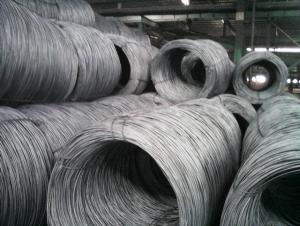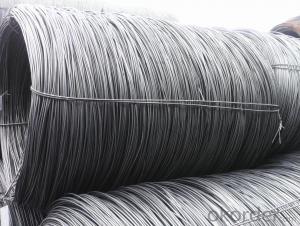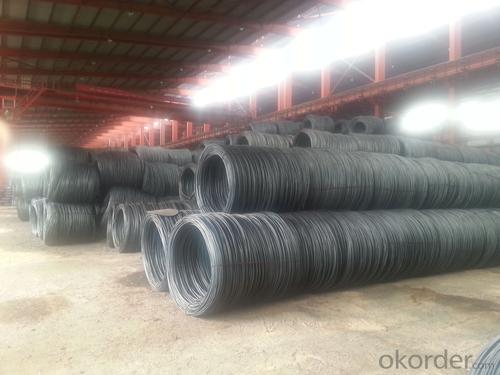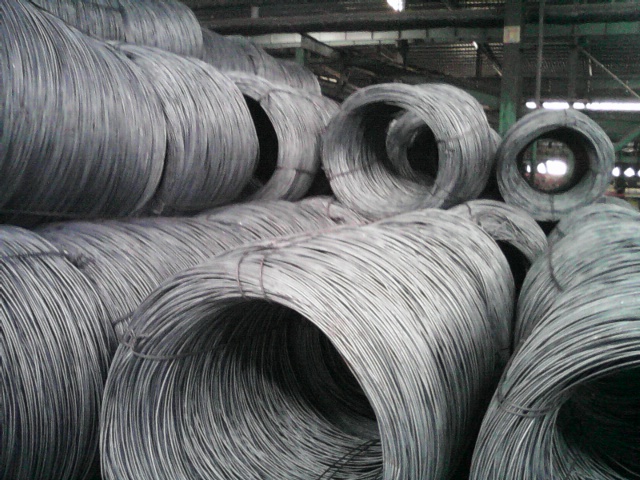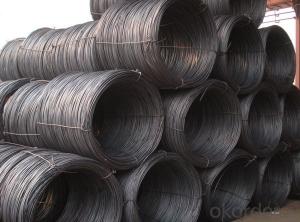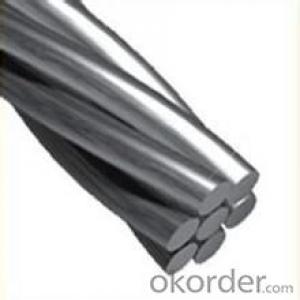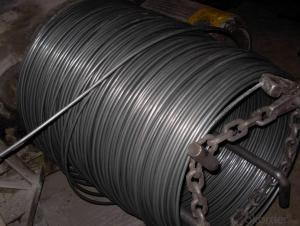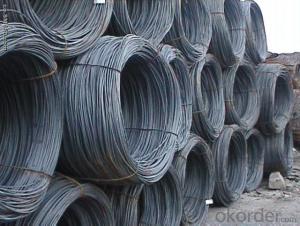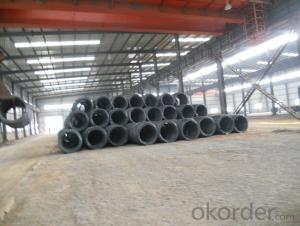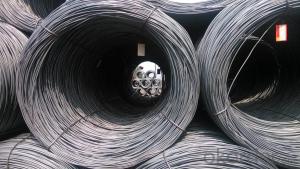Hot Rolled Carbon Steel Wire Rod in Coil
- Loading Port:
- China Main Port
- Payment Terms:
- TT or LC
- Min Order Qty:
- -
- Supply Capability:
- -
OKorder Service Pledge
OKorder Financial Service
You Might Also Like
Product Description:
OKorder is offering Wire Rod at great prices with worldwide shipping. Our supplier is a world-class manufacturer of steel, with our products utilized the world over. OKorder annually supplies products to European, North American and Asian markets. We provide quotations within 24 hours of receiving an inquiry and guarantee competitive prices.
Product Applications:
After hot-rolled the products shaped into coil and delivery as finished product, including round, square, rectangular, hexagonal and so on. Since most of the products are round, it is generally called wire rod. Carbon steel wire rod is widely used in construction and manufacturing. Carbon steel wire rod is mainly used for reinforcement of reinforced concrete and welded structure or reprocessed (roberts , nail, etc.) materials, especially used to produce wire drawing, welding electrode, nails, spring, electronic, precise machinery parts and so on.
Product Advantages:
OKorder's Wire Rod are durable, strong, and resist corrosion.
Main Product Features:
· Premium quality
· Prompt delivery & seaworthy packing (30 days after receiving deposit)
· Corrosion resistance
· Can be recycled and reused
· Mill test certification
· Professional Service
· Competitive pricing
Product Specifications:
Steel Grade: Q195/235, SAE1006-1018B Standard: ASTM, GB
Diameter: 5.5mm, 6.5mm, 7mm,8mm,9mm,10mm,12mm,14mm
Type: in coil, coil weight around 2MT Alloy or Not: Alloy
Surface: round, no twisted, light and smooth Chemical Composition: (Please kindly find our chemistry of our material based on Q195、Q235A and Q235B as below for your information)
Grade | Chemical Composition (%) | |||||
C | Mn | S | P | Si | B | |
SAE1008B | 0.10max | 0.32max | 0.045max | 0.040max | 0.30max | 0.0008min |
Mechanical properties | ||||||
Yield strength(N/mm2) | Tensile strength(N/mm2) | Elongation (%) | ||||
≥195 | 350-380 | ≥32 | ||||
Note:
1. Our products are produced according to national standard (GB), if not, supply according to national standards (GB) or agreement as customer required.
2. Other Grade and Standard carbon steel wire rod we can supply:
Grade: H08A, 30MnSi, 62B-82B
Standard: AISI, BS, JIS, DIN
The Minimum Order Quantity of these products is high, and need to be confirmed.
3. We can not only supply carbon steel wire rod; if you need anything about building materials, please contact us.
4. Please send us your detail specifications when inquire. We will reply to you as soon as possible. We sincerely hope we can establish a long stable business relationship.
FAQ:
Q1: How soon can we receive the product after purchase?
A1: Within three days of placing an order, we will begin production. The specific shipping date is dependent upon international and government factors, but is typically 7 to 10 workdays.
Q2: How do we guarantee the quality of our products?
A2: We have established an advanced quality management system which conducts strict quality tests at every step, from raw materials to the final product. At the same time, we provide extensive follow-up service assurances as required.
Q3: Can stainless steel rust?
A3: Stainless does not "rust" as you think of regular steel rusting with a red oxide on the surface that flakes off. If you see red rust it is probably due to some iron particles that have contaminated the surface of the stainless steel and it is these iron particles that are rusting. Look at the source of the rusting and see if you can remove it from the surface.
Images:
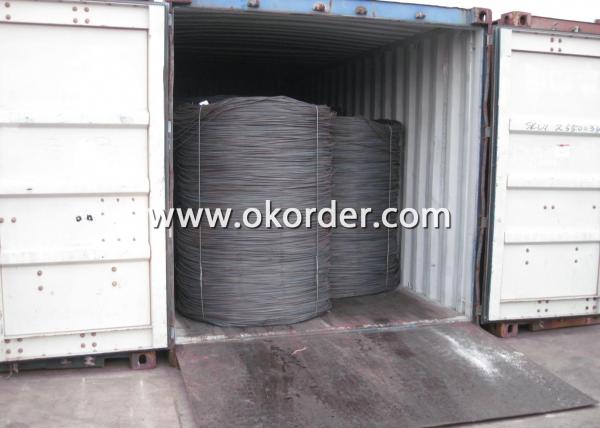
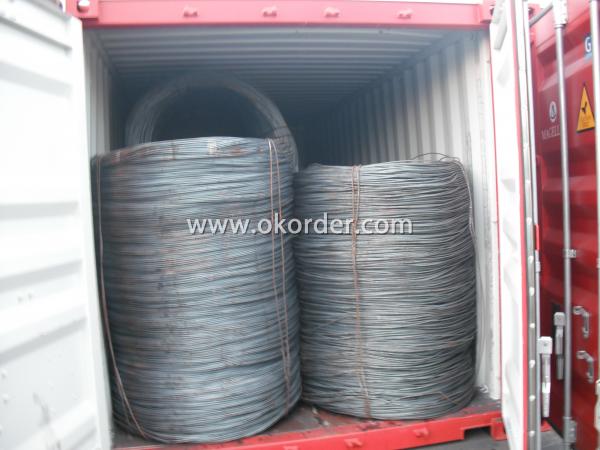
- Q: How is steel wire rod used in the manufacturing of suspension cables for bridges?
- Due to its strength and durability, steel wire rod is crucial for producing suspension cables used in the construction of bridges. These cables bear the weight of the bridge deck and transfer the load to the bridge towers or anchorages. To enhance their mechanical properties, steel wire rods undergo a series of heat treatments during the manufacturing process. This includes annealing, which softens the steel and increases its malleability, as well as quenching and tempering, which enhance its strength and toughness. These treatments enable the wire rods to withstand the high tension and stress experienced by suspension cables. Once the wire rods have been appropriately treated, they are further processed into wire strands by twisting multiple wire rods together. These wire strands are tightly wrapped around a central core, forming the main body of the suspension cables. The number and arrangement of the wire strands may vary depending on the bridge's design and load requirements. Using steel wire rod in suspension cables offers several advantages. Its high tensile strength enables the cables to resist the significant forces exerted on the bridge, including the weight of the deck, live loads, wind loads, and seismic forces. Additionally, the durability of steel wire rod ensures that the suspension cables can maintain their structural integrity for many decades. Furthermore, steel wire rod is highly resistant to corrosion, making it suitable for outdoor applications, even in harsh environments. This corrosion resistance is especially important for suspension cables, as they are continuously exposed to environmental factors like moisture, humidity, and temperature fluctuations. By utilizing steel wire rod, the risk of deterioration and failure due to corrosion is significantly reduced, ensuring the longevity and safety of the bridge. In conclusion, steel wire rod plays a vital role in the production of suspension cables for bridges. Its strength, durability, and corrosion resistance make it an ideal material for withstanding the high tension and stress experienced by the cables. By utilizing steel wire rod, suspension cables can provide the necessary support to bridges, ensuring their long-term structural integrity and safety.
- Q: How is the bending properties of steel wire rod tested?
- The bending properties of steel wire rod are typically tested through a method called the bend test. In this test, a sample of the wire rod is bent to a specific angle or curvature and then examined for any signs of cracking or breaking. The test is conducted by securing one end of the wire rod and applying a force to the other end to bend it. The amount of force required to achieve the desired bend is measured, and the wire rod is visually inspected for any signs of deformation or fracture. Additionally, the test may involve measuring the diameter of the wire rod before and after bending to assess any changes in its physical properties. The bend test provides valuable information about the flexibility and ductility of the steel wire rod, which is crucial in determining its suitability for various applications.
- Q: How is the corrosion resistance of steel wire rod evaluated?
- The corrosion resistance of steel wire rod is typically evaluated through various tests and assessments. These may include conducting salt spray tests to simulate harsh environmental conditions, measuring the rate of corrosion using electrochemical techniques like polarization resistance or linear polarization, and analyzing the composition and microstructure of the wire rod to determine its susceptibility to corrosion. Additionally, real-world exposure tests and long-term monitoring are often carried out to assess the overall performance and durability of the steel wire rod in corrosive environments.
- Q: What are the common material specifications for steel wire rod?
- The material specifications for steel wire rod are typically determined by the specific requirements of the industry or application in which it will be used. However, there are some general material specifications commonly found in steel wire rod. One crucial aspect to consider is the chemical composition of the steel wire rod. It is usually made from carbon steel, which contains varying amounts of carbon and other alloying elements like manganese, silicon, and sulfur. The exact composition depends on the desired mechanical properties and intended application. Another important factor is the size and shape of the steel wire rod. Typically, it comes in coils with diameters ranging from a few millimeters to several centimeters. The specific size and shape depend on the end product's requirements, including strength, flexibility, and conductivity. The mechanical properties of the steel wire rod are also specified, including tensile strength, yield strength, and elongation. These properties determine the wire rod's ability to withstand forces and deformations without breaking. Achieving these properties requires specific manufacturing processes and heat treatments. Surface quality requirements, such as smoothness, cleanliness, and absence of defects, are other common material specifications for steel wire rod. Additionally, certain industries or applications may have specific requirements for corrosion resistance, electrical conductivity, or thermal conductivity. It's important to note that material specifications can vary significantly depending on the industry or application. Therefore, carefully reviewing the requirements and consulting industry standards or experts is crucial to ensure the appropriate material specifications are met for the intended use of the steel wire rod.
- Q: How are steel wire rods used in the production of wire ropes for ships?
- Steel wire rods are a crucial component in the production of wire ropes for ships. These rods serve as the raw material from which the wire ropes are manufactured. Firstly, steel wire rods are subjected to a series of processes to transform them into wire strands. These processes involve drawing the rods through a series of dies to reduce their diameter and increase their length. This results in the formation of thin, elongated wire strands. Next, these wire strands are twisted together to form a cable core. The number of strands used and the direction of the twist depend on the specific requirements of the wire rope. This cable core provides the foundation and strength for the wire rope. After the cable core is formed, it is typically covered with an outer layer known as the wire rope's outer strands. These outer strands are also made using steel wire rods. The outer strands are twisted around the cable core in a specific pattern to ensure strength, flexibility, and durability. The use of steel wire rods in the production of wire ropes for ships is essential due to the material's excellent properties. Steel is known for its high tensile strength, corrosion resistance, and durability, making it ideal for maritime applications. These qualities allow wire ropes made from steel wire rods to withstand the extreme forces and harsh environments experienced at sea. In conclusion, steel wire rods play a vital role in the production of wire ropes for ships. These rods are transformed into wire strands, which are then twisted together to create the cable core. The cable core is further covered with outer strands, resulting in a strong and resilient wire rope that can withstand the demanding conditions of maritime operations.
- Q: How is the steel wire rod market affected by fluctuations in foreign exchange rates?
- The steel wire rod market is significantly affected by fluctuations in foreign exchange rates. As a highly globalized market, steel wire rod is often traded internationally, and its prices are influenced by currency exchange rates. When a country's currency weakens against major foreign currencies, it makes its exports more competitive in international markets. This can lead to increased demand for steel wire rod from that country as it becomes cheaper for foreign buyers. Consequently, the steel wire rod market experiences a boost in sales and prices may rise due to increased demand. Conversely, when a country's currency strengthens, its exports become more expensive for foreign buyers. This can result in a decrease in demand for steel wire rod from that country, leading to lower sales and potential price reductions. Fluctuations in foreign exchange rates can create uncertainty and volatility in the steel wire rod market, making it challenging for manufacturers, suppliers, and distributors to plan and forecast their operations. Moreover, currency fluctuations can impact the cost of raw materials and production processes. Steel wire rod manufacturers often rely on imported raw materials, such as iron ore and scrap metal, which are priced in foreign currencies. If a country's currency weakens, the cost of importing these raw materials may increase, leading to higher production costs and potentially higher steel wire rod prices. Additionally, foreign exchange rates affect the competitiveness of steel wire rod imports. When a country's currency strengthens, it becomes more cost-effective to import steel wire rod from other countries. This can lead to increased competition for domestic manufacturers, potentially resulting in reduced market share and profitability. In summary, fluctuations in foreign exchange rates have a significant impact on the steel wire rod market. They affect the competitiveness of exports, the cost of raw materials, the pricing of steel wire rod, and the competitiveness of imports. Steel wire rod market participants must closely monitor and analyze foreign exchange rates to anticipate and respond to market dynamics effectively.
- Q: What are the main factors influencing the choice of steel wire rod surface finish?
- The main factors influencing the choice of steel wire rod surface finish include the intended application of the wire rod, desired mechanical properties, corrosion resistance requirements, aesthetic considerations, and production costs.
- Q: How is steel wire rod used in the manufacturing of wire containers?
- Wire containers, which are widely utilized in logistics, warehousing, and transportation industries due to their durability, strength, and versatility, heavily rely on steel wire rod as a crucial component. To begin the manufacturing process, steel wire rod undergoes a series of procedures, including drawing, annealing, and coating, in order to transform it into wire. This wire is then shaped and welded according to the desired container design, whether it be a basket, cage, or pallet. The high tensile strength of steel wire rod guarantees that wire containers can endure heavy loads and avoid deformation, making them suitable for the storage and transportation of various goods. Furthermore, the durability of steel wire rod enables wire containers to withstand harsh environments, such as extreme temperatures and corrosive substances. The flexibility of steel wire rod also allows for customization of wire containers. Manufacturers can easily adjust the wire's diameter, length, and thickness to meet specific requirements. This adaptability enables the production of wire containers in different sizes and designs, ensuring their compatibility with a wide range of products and storage systems. Additionally, wire containers made from steel wire rod are lightweight, making them easier to handle and transport. This feature is particularly advantageous in industries that require frequent loading and unloading of goods. In conclusion, steel wire rod plays a vital role in the manufacturing of wire containers by providing the necessary strength, durability, and flexibility. Its utilization ensures the creation of reliable and efficient storage and transportation solutions for various industries.
- Q: How is steel wire rod used in the production of suspension springs for automobiles?
- Steel wire rod is commonly used in the production of suspension springs for automobiles due to its high strength and durability. The wire rod is first straightened and then coiled into the desired shape and size to form the suspension spring. The coiled wire rod is then heat-treated to enhance its mechanical properties and make it more resistant to fatigue. This process ensures that the suspension spring can withstand the weight of the vehicle and provide a smooth and comfortable ride by absorbing shocks and vibrations from the road.
- Q: What are the standard hardness requirements for steel wire rod?
- The standard hardness requirements for steel wire rod are contingent upon various factors, including the intended use and specific industry standards. However, there exist some general principles that can be adhered to. In most instances, the hardness of steel wire rod is gauged using the Rockwell hardness scale. The particular Rockwell hardness (HRC) requirement may differ based on the grade and type of steel wire rod. For instance, low carbon steel wire rod typically falls within the range of 45 to 55 HRC, whereas high carbon steel wire rod may necessitate a hardness requirement of 55 to 65 HRC. Moreover, industry standards like ASTM (American Society for Testing and Materials) or ISO (International Organization for Standardization) may proffer specific hardness requirements for different grades and applications of steel wire rod. These standards guarantee that the wire rod satisfies the requisite mechanical properties for its intended use, encompassing strength, ductility, and wear resistance. It is important to note that the hardness requirements for steel wire rod can also be influenced by customer specifications or specific manufacturing processes. For example, wire rods employed in the production of springs or cables may necessitate more stringent hardness requirements in comparison to those utilized for general applications. Ultimately, it is advisable to consult the pertinent industry standards, customer specifications, or specific product requirements to ascertain the standard hardness requirements for steel wire rod within a given context.
Send your message to us
Hot Rolled Carbon Steel Wire Rod in Coil
- Loading Port:
- China Main Port
- Payment Terms:
- TT or LC
- Min Order Qty:
- -
- Supply Capability:
- -
OKorder Service Pledge
OKorder Financial Service
Similar products
Hot products
Hot Searches
Related keywords

